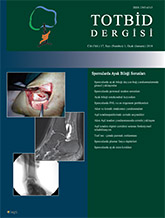
Os trigonum syndrome and flexor hallucis longus (FHL) tenosynovitis are frequently encountered problems in patients who regularly participate in activities that require hyperplantarflexion of the ankle such as ballet, football or basketball. Patients complain of posterior ankle pain. Pain on the posterolateral side of the ankle and positive posterior impingement test are typical findings of symptomatic os trigonum. Patients with FHL tenosynovitis usually have pain at the posteromedial ankle, and their physical exam reveal pain along the posteromedial ankle with deep palpation. Os trigonum syndrome can readily be diagnosed with history and physical examination findings but weight-bearing lateral radiographies can also reveal os trigonum. Accompanying soft tissue pathologies like FHL tenosynovitis can be diagnosed with the help of magnetic resonance imaging. Nonoperative management typically involves modification of activities, rest, oral anti-inflammatory medications and ice application. Dissatisfied patients with the outcomes of conservative treatment are candidates for open or arthroscopic surgery. Because of the lower complication rates and faster recovery, arthroscopic surgery is accepted as the golden standard for the treatment of these pathologies.